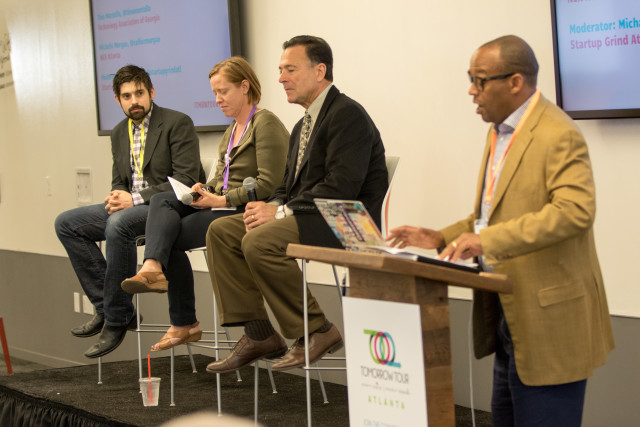Megan Zlock started out studying animation at the University of Maryland, Baltimore County. As a kid, she reveled in math and the arts; the perfect combination of the left- and right-brain. Animation for video games, Zlock said, seemed to be a good fit.
But after receiving her BFA at UMBC, Zlock found the industry wasn’t for her.
She headed back to school, this time at the Center for Design and Imaging Arts, which used to have a Georgetown location. Zlock earned a professional certificate in web design and development and quickly found herself a job at iStrategyLabs as a creative technologist.
Front-end development brought everything together for Zlock. She found she was good at understanding and communicating with designers. To maintain her artistic abilities on the side, Zlock took on some freelance work — she creates the portraits of the illustrators on National Geographic’s Your Shot site — and kept drawing and doing digital painting as a hobby.
After finding her bearings as a front-end developer, Zlock moved on to Viget (pronounced with a hard “g”), a 15-year-old agency that works with brands and startups on design projects while also building digital platforms and products.
Earlier this year, DCFemTech recognized Zlock as one of D.C.’s 30 “Powerful Women Programmers.”
Zlock sat down with Technical.ly DC in Viget’s new-ish headquarters in Falls Church to talk about her work habits and why Slack is so damn distracting.
###
What do you like about working at Viget?
I do like agency work. I like variety. I’m on a new project every once in awhile and get to start new things. And Viget is a really good version of an agency. There are people who have been here for a very long time, they’re family-focused, and there are excellent benefits. It feels like I can be here long-term. A lot of agencies aren’t like that. You get the younger crowd and they’re here for two or three years, and then they’re done. But everybody here has some tenure and sticks around. The work is also challenging.
Is your work now what you set out to do?
When I first started working, I wanted to be that mix of a designer and a developer. I liked the variety of the work and how I could be a little bit of a designer and a little bit of a developer.
Now I don’t do as much design as I originally set out to do. My original idea of doing a little bit of both was a bit naïve. I learned really quickly that there’s so much more of a demand for front end, and that’s what I really enjoyed doing. I don’t really miss the design stuff. I can do color, and I’m really good at drawing, so I have an eye for composition, but I really struggle with typography. It takes me a really long time to pick out type. That’s probably my worst spot when it comes to design.
But the designers I work with really appreciate that I have an eye for those kinds of things.
What’s the first thing you do in the morning before sitting down at a computer?
Honestly, the first thing I do is sit down to do a cursory email glance just to make sure no fires or anything happened over the evening. But pretty quickly, I’ll go and get my coffee. Then I’ll really sit down and read through everything.
That’s my first step: I assess my day by reading through emails and assessing my schedule. Also, we work by hours here so I’ll double check my schedule to see how many hours I’m supposed to be working on each project. Particularly if I’m not sure what I should be working on that day. I might check in with the designer or copywriter on a project.
What’s the workflow like between you and your coworkers?
When it comes to the code side of things, I usually have a checklist, and I’m issued tickets to knock out as they come in. But as far as working with my other teammates, I do like to be very collaborative with our designers. As I’m building things or as the designer’s designing things, we’re constantly checking in with each other.
In the project I’m working on now, the design phase is ending, so I’ll check in the designer, or rather he’ll grab me. We’ll come over and look at the same screen and see what’s going to be easy or hard.
As a developer I know sometimes designers don’t know what’s hard or what’s easy. I try to give an alternative. I don’t like to just say no. I love what the designers come up with, so I always try to put in the effort.
On another project, the designer had used a multiply effect, and I was like, “How am I going to do that?” But after a little bit of research, I found out it’s totally easy with SVGs. So I try to do a little research to see if maybe I can do it instead of shutting something down completely. When the designer’s working, I like to check in a lot. And when I’m working, I like to check in with the designer a lot. Especially working responsively, there are always some gaps that they don’t get to. There are always areas that aren’t covered.
What coding tools do you use?
All of our coding tools make everything so quick and easy to change things. I love having them just sitting next to me.
Depending on the website, we have different tech stacks. I work with Craft CMS a lot. It actually reminds me a lot of WordPress, but it’s a step up. You bring all of your own markup. In WordPress, you always have to use their API to get the markup that you want. In Craft you start from scratch. There is absolutely nothing there, and you just build entirely up from scratch, which I love. I’m an OCD developer and I want the HTML to be a very specific way, and Craft lets me do that very easily.
As far as build tools, we use Gulp. Dan [Tello], who is my coworker here at Viget, kind of pioneered doing this Gulp starter that he has on GitHub that I steal from routinely. He’s always improving it and making it better. Gulp kind of packages up everything really nicely.
How much of your day is you sitting down at your computer working versus collaborating?
It varies by the type of project. With the larger projects, things get too massive to be too organic with it. You have your checklist and you have to work through that checklist.
On the smaller ones when you’re going through the ideation phase, you can be a lot more collaborative. That’s probably my favorite part of a project: When it first starts. That’s when we’re all white-boarding together and getting everything filled out.
What do you do when you need a break?
I do like to get up and get away from my desk. Now that we’re in our new office, I like to come upstairs. We have our nice fruits and vegetables in the kitchen, so I’ll come up and get a banana or something. When we used to be at the temp space, there was a park right there, so it was nice to walk around the park for a bit.
I do like to take breaks. I never eat lunch at my desk. I also like to leave myself open for people to grab me. Even if I have my headphones in, I’m happy to put things down for a minute and talk about something. Talking person-to-person is so much more productive. We can go back and forth on chat, and we can go back and forth on email, but it’s just going to take longer for us to get to a good decision, or we might misunderstand each other. I don’t mind if people tap me on the shoulder, and say, “Let’s figure this out now.”
From when you first started working to now, is there anything you do differently that makes you a better worker?
One thing I’ve learned — and I think a lot of developers struggle with this — is going home and turning off. It makes me much more productive. It doesn’t help if I go home and work more, and then I’m tired the next day. I end up being less productive. It helps for me, and Viget is very supportive of this.
Tracking hours at Viget has helped me keep track of how productive I am too. It made me realize when I’m more productive and when I’m not. I usually get a really good chunk of work done right after lunch because I’ve been up, moved around, and now I’m sitting and focused.
It’s also really important who you work with. I love the team at Viget because professional development is a big thing. We’re always teaching each other new things and pushing each other. It’s just expected here that we’re constantly learning.
Are there any intra-office tools you use to communicate?
We use Slack, and it is immensely distracting. I’m still trying to figure out how to make it not distract me as much. I’m constantly checking it.
We also have Basecamp and email. We use Slack a lot and use Basecamp a lot with clients. Email is my last resort.
What did you use before Slack? What distracts you particularly about Slack?
Before, we used a mix of Gchat and Campfire.
The different channels of Slack distract me. The application I used Campfire through kind of limited how many channels you had open. It had a tab interface, so I would purposely limit that. In Slack, there’s no visual thing that makes me feel like I need to close some windows. I can join as many chatrooms as I want. The more you’re in, the noisier it gets because people are @channeling and direct messaging.
We also have a little more traffic because of the integrations that Slack has. GitHub will tell you if something deployed. And we have the system set up to have you check other people’s [pull requests] every two hours, so you’ll get a message saying, “Check these!”
And yeah, lots of GIFs.
Join the conversation!
Find news, events, jobs and people who share your interests on Technical.ly's open community Slack

DC daily roundup: Washington Post's AI collab; a greentech glossary; Halcyon's debut Climate Fellowship cohort

DC daily roundup: Inside UMCP's new ethical AI project; HBCU founder excellence; a big VC shutters MoCo office

DC daily roundup: Esports at Maryland rec center; High schoolers' brain algorithm; Power data centers with coal?


